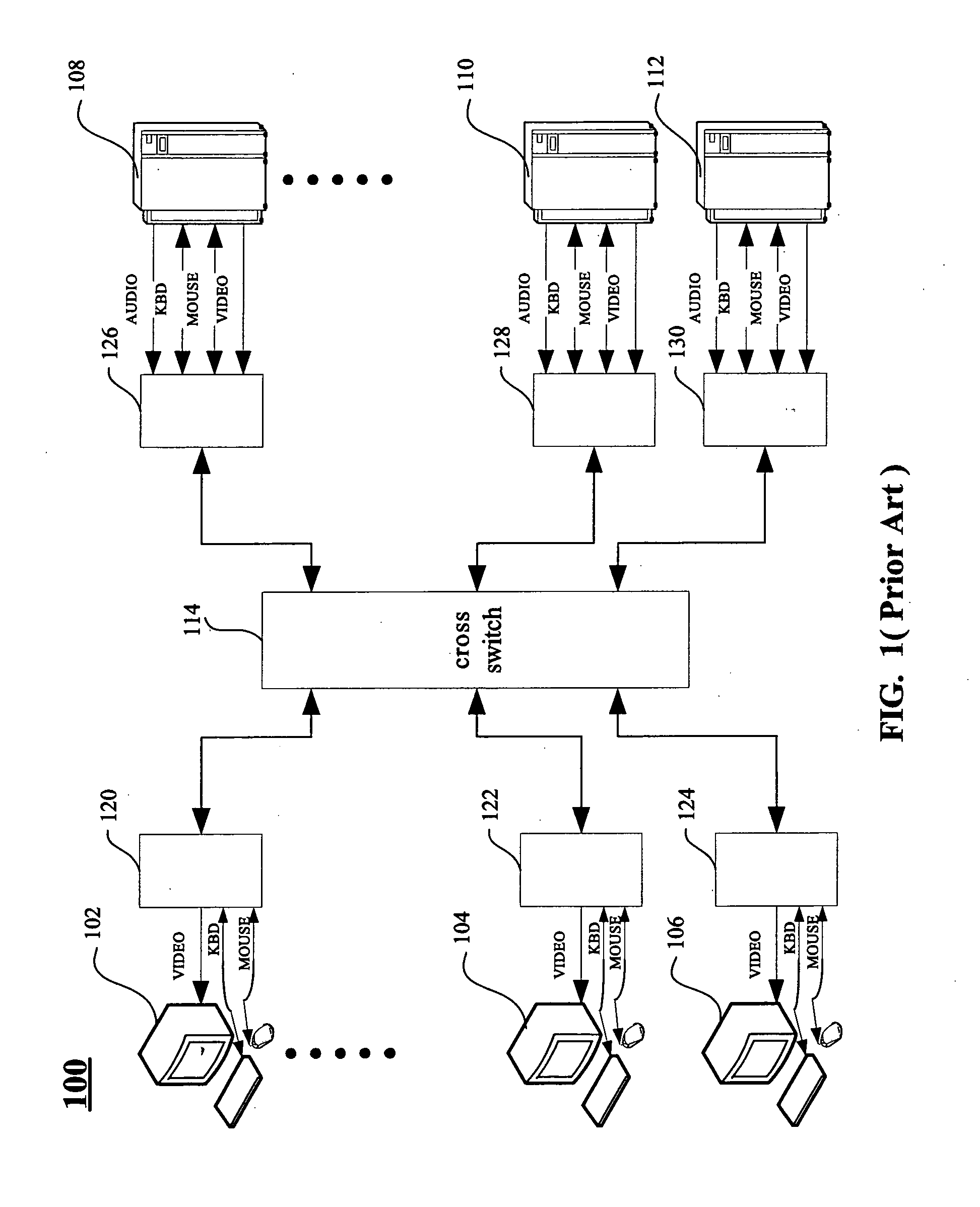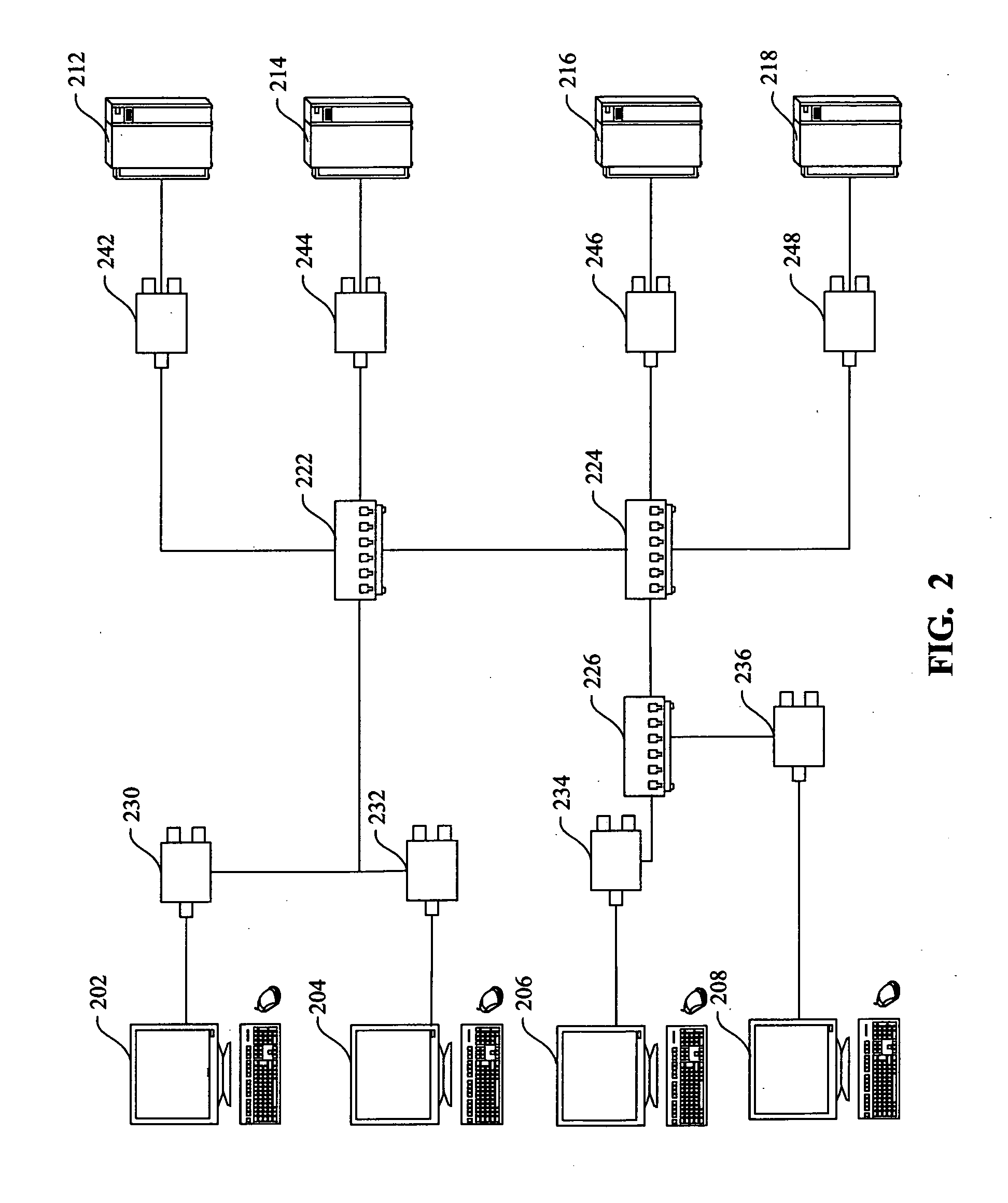Matrix architecture for KVM extenders
a technology of matrix architecture and extender, applied in the field of matrix architecture, can solve the problems of inability to work as far as practicable without cross switch, complex and costly cross switch 114, and each user operating at the remote console device takes a risk equally, so as to prevent the decay of signal transmission, simplify the structure, and extend the distance between the console terminal and the computer.
- Summary
- Abstract
- Description
- Claims
- Application Information
AI Technical Summary
Benefits of technology
Problems solved by technology
Method used
Image
Examples
first embodiment
[0022] Please referring to FIG. 2, which shows the matrix architecture for KVM extenders to broadcast keyboard-video-mouse data packets via broadcasters among the console terminals and computers of the present invention. It extends the distance and the simple components inside the first and second extender and avoids that the “whole network” gets down, following that the matrix KVM switch gets crashed in case of using only one cross switch for transmitting signals, since there is only one route between each of the console terminals and each of the computers. The purpose of one or more routes between each console terminal and each computer is to erase the probability of the whole network's getting crashed caused by the cross switch for transmitting signals centrally. With the appropriate wiring arrangement for the broadcasters in the matrix architecture, the object can be achieved. First, the console terminals (202, 204, 206, 208) and the computers (212, 214, 216, 218) own the uniqu...
second embodiment
[0027] Please further referring to the FIG. 3, which is the matrix architecture for KVM extenders to broadcast keyboard-video-mouse data packets via broadcasters among the console terminals and computers according to the present invention. For example, the user is controlling the computer 212 at the console terminal 202 through the first extender 230 coupled to the console terminal 212 and the second extender 242 coupled to the computer 202. Normally, the route is hub 304-hub 310. If hub 304 crashed, the route changes to another route, such as hub 306-hub 302-hub 310. If hub 310 crashed, the route changes to another route, such as hub 304-hub 302-hub 308. If hub 304 and hub 310 crashed, the route changes to another route, such as hub 306-hub 308. Here is the illustration of the console terminal 202 goes with the computer 212. Various combinations of the console terminals and computers can achieve the same result.
third embodiment
[0028] Please referring to FIG. 4 which shows third embodiment of the matrix architecture for KVM extenders to broadcast keyboard-video-mouse data packets via broadcasters among the console terminals and computers according to the present invention and FIG. 3. Such as the users are controlling either the computer (212, 214) at the console terminals 202 or 204 through the first extenders (230, 232) coupled to console terminals (212, 214), respectively and the second extenders (242, 244) coupled to the computers (212, 214), respectively. There will be at least two routes provided to broadcast the keyboard, mouse data packets from each of the console terminals to each of the computers in the matrix architecture or broadcast the video data packets in reverse order. As a result, the crash of the network caused by the failure of the only one cross switch transmitting signals can be avoided with such appropriate wiring arrangement for the hubs in the matrix architecture. Meanwhile, the pre...
PUM
 Login to View More
Login to View More Abstract
Description
Claims
Application Information
 Login to View More
Login to View More - R&D
- Intellectual Property
- Life Sciences
- Materials
- Tech Scout
- Unparalleled Data Quality
- Higher Quality Content
- 60% Fewer Hallucinations
Browse by: Latest US Patents, China's latest patents, Technical Efficacy Thesaurus, Application Domain, Technology Topic, Popular Technical Reports.
© 2025 PatSnap. All rights reserved.Legal|Privacy policy|Modern Slavery Act Transparency Statement|Sitemap|About US| Contact US: help@patsnap.com



